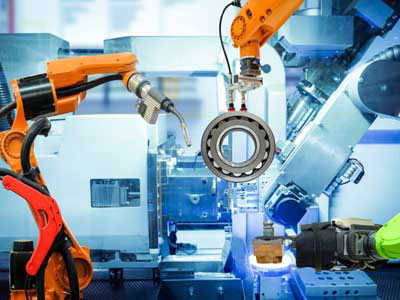Key Takeaway
An example of an industrial robot is the Cartesian robot. This type of robot is widely used in industrial settings, especially for CNC machines and 3D printing. Cartesian robots operate on three linear axes (X, Y, and Z), allowing precise control over movements. They are highly efficient for tasks requiring accurate and repetitive actions. For instance, in a CNC machine, a Cartesian robot can precisely cut, drill, or shape materials. Similarly, in 3D printing, it can build objects layer by layer with high precision. Their simplicity and accuracy make Cartesian robots a popular choice in many industrial applications.
Articulated Robot Example
Articulated robots, with jointed arms resembling human arms, are widely used in assembly lines for their flexibility and extensive range of motion. They excel in tasks requiring precise movements across multiple axes, such as welding, painting, and material handling. Their ability to mimic human arm movements makes them indispensable in industries that demand intricate operations, ensuring high efficiency and accuracy. These robots’ versatility and precision enhance productivity and consistency in various industrial applications.

SCARA Robot Example
SCARA robots, short for Selective Compliance Assembly Robot Arms, stand out in industrial automation for their exceptional speed and precision in horizontal movements. These robots are extensively used across various industries, including electronics and automotive sectors, where rapid and accurate assembly processes are critical.
Precision and Speed in Action
In the electronics industry, SCARA robots are deployed for tasks that demand meticulous handling of small components with minimal margin for error. For instance, in printed circuit board (PCB) assembly lines, SCARA robots excel in pick-and-place operations, ensuring components are accurately positioned at high speeds. This not only enhances production efficiency but also reduces wastage, as these robots can perform repetitive tasks consistently without fatigue or error.
Versatility and Flexibility
Another key advantage of SCARA robots lies in their versatility. Beyond electronics, these robots find applications in packaging lines where they swiftly handle items for sorting, packing, and palletizing. Their ability to adapt to various tasks within a production line makes them invaluable assets for optimizing workflow and maximizing throughput.
Delta Robot Example
Delta robots, characterized by their parallel-link structure, are designed to meet the demands of high-speed and high-precision operations in industries such as food processing and pharmaceutical manufacturing. These robots are engineered to excel in environments where rapid throughput and stringent accuracy are paramount.
Precision in Delicate Operations
In food processing plants, Delta robots play a crucial role in handling delicate items such as confectioneries and baked goods. Their ability to swiftly pick, place, and package items ensures that products are handled gently to maintain quality and integrity throughout the production process. This precision is essential in meeting industry standards and consumer expectations for consistency and hygiene.
Adaptability and Efficiency
The lightweight design of Delta robots, coupled with their agile maneuverability in confined spaces, enhances operational efficiency in tight production environments. In pharmaceutical manufacturing, for example, these robots perform tasks like sorting medications and packaging units with precision, reducing human error and ensuring compliance with stringent regulatory requirements.
Cartesian Robot Example
Cartesian robots, often referred to as gantry robots, are pivotal in industries requiring precise and robust automation solutions. These robots utilize three linear axes—X, Y, and Z—to navigate and operate in a rectilinear manner. This configuration allows them to achieve high accuracy and repeatability, making them ideal for applications such as CNC machining, 3D printing, and large-scale material handling in warehouses and logistics centers.
Precision and Capability
The key strength of Cartesian robots lies in their ability to execute movements with pinpoint accuracy. Each axis operates independently, controlled by sophisticated software that coordinates their motion to achieve precise positioning within micrometer-level tolerances. This capability is crucial in industries where the quality of output hinges on exact specifications, such as in the fabrication of intricate machine parts or the layer-by-layer deposition of materials in additive manufacturing processes like 3D printing.
These robots are also capable of handling substantial payloads, ranging from a few kilograms to several tons, depending on their design and application. This heavy payload capability makes them indispensable in environments where moving and manipulating large objects with high precision is essential, such as in automotive assembly lines or the loading and unloading of heavy pallets in logistics operations.
Collaborative Robot Example
Collaborative robots, commonly known as cobots, represent a new era in industrial automation designed to work alongside human operators safely and efficiently. Unlike traditional industrial robots that require physical barriers or cages to ensure human safety, cobots are equipped with advanced sensors and programming that allow them to operate safely in close proximity to humans.
Safety and Flexibility
The primary advantage of cobots lies in their ability to collaborate directly with human workers without compromising safety. These robots are equipped with sensors that enable them to detect the presence of humans and adjust their speed and force accordingly to prevent accidents. This capability makes them suitable for tasks such as assembly, inspection, and small parts handling in industries ranging from electronics manufacturing to healthcare settings where precision and safety are paramount.
Cobots are also characterized by their flexibility and ease of deployment. Unlike traditional industrial robots that often require extensive programming and integration into existing production lines, cobots are designed to be easily programmable by non-experts. This feature allows them to be quickly reconfigured to perform different tasks, making them particularly valuable in environments where production needs change frequently or where there is a high mix of products with varying assembly requirements.
Conclusion
Industrial robots come in various types, each designed for specific needs, such as precision, speed, collaboration, and safety. These robots revolutionize modern manufacturing by enhancing efficiency, safety, and productivity. As industries evolve, integrating these robots continues to transform production processes. This overview offers insights into their pivotal role, providing clarity and relevance for engineers and enthusiasts. Industrial robots showcase the transformative power of robotics in industrial applications.
